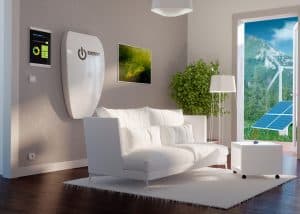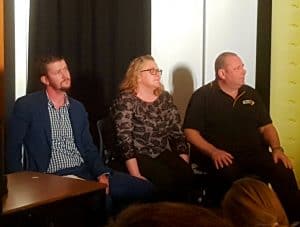It is the twentieth anniversary of the explosive demolition of the Canberra Hospital. The demolition was meant to be an implosion but instead debris scatter well outside the designated safety zone resulting in the death of one person and injuries to nine. Such events are significant at the time but fade from memory until anniversaries are noted, however, there are important occupational health and safety (OHS) lessons from such incidents which do not have the drama of a Piper Alpha or a Challenger but are nevertheless as instructive.
Category: consultation
Risk assessment early in development of residential storage battery standard
 Australia’s Royal Commission into Home Insulation program (HIP) seemed to have had little long-term impact beyond the closing of the environmental subsidy scheme and political attacks. However, controversial environment reporter, Graham Lloyd, in an article in The Australian on 11 July 2017 (only available through paywall), has identified a HIP legacy as causing restrictions on the installation of residential batter storage. Continue reading “Risk assessment early in development of residential storage battery standard”
Australia’s Royal Commission into Home Insulation program (HIP) seemed to have had little long-term impact beyond the closing of the environmental subsidy scheme and political attacks. However, controversial environment reporter, Graham Lloyd, in an article in The Australian on 11 July 2017 (only available through paywall), has identified a HIP legacy as causing restrictions on the installation of residential batter storage. Continue reading “Risk assessment early in development of residential storage battery standard”
WorkSafe responds on Strategy 2030
Last week SafetyAtWorkBlog wrote about the release of a WorkSafe Victoria Strategy 2030 discussion paper. WorkSafe has responded to a series of questions that were clear and straightforward. The response is largely unhelpful.
“The discussion paper seeks feedback on WorkSafe’s next long term strategy which will support an even greater focus on injury prevention, the provision of tailored services and empathetic support to every injured worker and the transformation of WorkSafe into a technologically agile organisation.
The discussion paper has been promoted with a series of community seminars across the state, shared on social media, and sent to our employees and key stakeholders to promote and encourage feedback among their networks.
Workplace safety affects every Victorian which is why we are seeking the views of employers, workers and the broader community.
A summary of the feedback will be made available on the WorkSafe website before the end of the year.”
The questions asked by SafetyAtWorkBlog are listed below.
RTW seminar hints at WorkSafe Victoria’s future
 Victoria Australia has had a network of safety groups for well over 40 years with two or three enduring into this century. On 5 July 2017, the Ballarat Regional Occupational Safety and Health Group (BROSH) held an interactive seminar on Return-To-Work (RTW). The discussion was not revolutionary but allowed the audience – a mix of businesses, OHS professionals and students – to speak about their lived experiences with managing injured workers.
Victoria Australia has had a network of safety groups for well over 40 years with two or three enduring into this century. On 5 July 2017, the Ballarat Regional Occupational Safety and Health Group (BROSH) held an interactive seminar on Return-To-Work (RTW). The discussion was not revolutionary but allowed the audience – a mix of businesses, OHS professionals and students – to speak about their lived experiences with managing injured workers.
I brought the WorkSafe 2030 Strategy discussion paper to the audience’s attention and a WorkSafe representative from the seminar’s panel, pictured above, said that there are several weird technical suggestions for workplace inspections and advice emerging from the discussion within the OHS regulator. However the strategy is focussed always on the client and that it is “prevention-led”. OHS is all about the prevention of illness and injury but it appears that WorkSafe is extending this term to RTW.
The representative explained that the regulator is looking at interventions that prevent an injury or illness claim transforming into, or contributing to, another and new injury. They hope that by focussing on the injured worker and providing the right level of advice and support, the will achieve the best RTW outcome for all involved.
One of the questions from the audience was if there is a better RTW and workers’ compensation system that Victoria could move to or learn from. The panel agreed that the Victorian system seems to be leading Australia in terms of its financial health but, more importantly, the level of care and support options provided to injured workers.
The BROSH seminar was well attended and the audience was active, which largely resulted from the innovative and engaging seminar structure.
No review report but WorkSafe Victoria releases a discussion paper on its future
 WorkSafe Victoria has released a discussion paper in support of its development of a WorkSafe Strategy 2030 but you wouldn’t know it. At the time of writing – there is no mention of it on the Facebook page, nothing on its news website. The paper is only available through this rarely used community engagement page.
WorkSafe Victoria has released a discussion paper in support of its development of a WorkSafe Strategy 2030 but you wouldn’t know it. At the time of writing – there is no mention of it on the Facebook page, nothing on its news website. The paper is only available through this rarely used community engagement page.
One of this blog’s readers drew attention to this paragraph on page 8 which indicates that WorkSafe Victoria is basing part of this discussion paper on recent reports which seem to include the Independent OHS Review which is yet to be publicly released:
“A number of independent reviews undertaken recently have also highlighted opportunities for us to strengthen our approach to regulating health and safety in Victorian workplaces, and in further supporting injured workers.
We know in some cases we are not meeting the expectations of the community, and the outcomes of these reviews are informing the development of our strategy, and the way we deliver our services in the future.”
It would be good to know what failed community expectations are being referred to.
Will we ever get to see Victoria’s latest OHS review?
 The Victorian (Labor) Government promised a review of WorkSafe Victoria’s enforcement policies in its 2014 campaign pledges as per the quote below. The independent occupational health and safety (OHS) review was conducted in 2016 with a lot of public submissions. The review’s final report was presented to the Victorian Minister for Finance, Robin Scott in December 2016. Everything has been quiet since. Continue reading “Will we ever get to see Victoria’s latest OHS review?”
The Victorian (Labor) Government promised a review of WorkSafe Victoria’s enforcement policies in its 2014 campaign pledges as per the quote below. The independent occupational health and safety (OHS) review was conducted in 2016 with a lot of public submissions. The review’s final report was presented to the Victorian Minister for Finance, Robin Scott in December 2016. Everything has been quiet since. Continue reading “Will we ever get to see Victoria’s latest OHS review?”
What is a safety professional and what do they do?
 David Provan recently provided access to one of his research papers through LinkedIn while it is open. The paper is a literature review of the factors shaping the role of a safety professional. It is a difficult and confusing read until one reaches the Conclusion. This is not Provan’s fault but is an indication of the confusing and conflicting roles, actions, obligations and qualifications of the occupational health and safety (OHS) professional revealed by the research literature.
David Provan recently provided access to one of his research papers through LinkedIn while it is open. The paper is a literature review of the factors shaping the role of a safety professional. It is a difficult and confusing read until one reaches the Conclusion. This is not Provan’s fault but is an indication of the confusing and conflicting roles, actions, obligations and qualifications of the occupational health and safety (OHS) professional revealed by the research literature.
However, the Conclusion provides a good summary of all the literature with some useful strategies to improve the OHS conversation.
